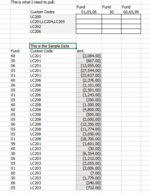Please help in fixing this issue with sumifs
Cell A1 to A100 has serial numbers 1 to 100, Cell B1 to B100 has corresponding sales values. I am trying to the get the total of values based on the criteria 45,55,65
Sumifs(B1:B100,A1:A100,criteria 1)
Here criteria 1 has to be 45, 55, 65
I hope you are able the understand the requirement, please help.. I need sumifs itself, since I have other criteria range and criteria which is unique.
Thank you.
Cell A1 to A100 has serial numbers 1 to 100, Cell B1 to B100 has corresponding sales values. I am trying to the get the total of values based on the criteria 45,55,65
Sumifs(B1:B100,A1:A100,criteria 1)
Here criteria 1 has to be 45, 55, 65
I hope you are able the understand the requirement, please help.. I need sumifs itself, since I have other criteria range and criteria which is unique.
Thank you.






